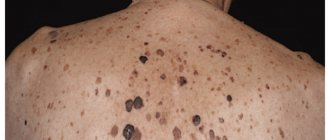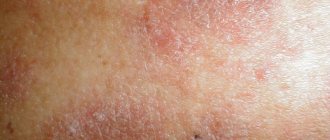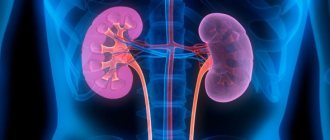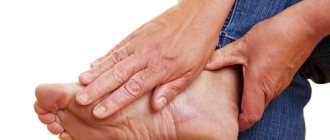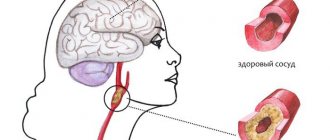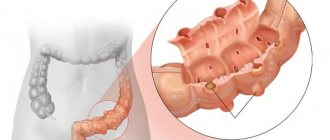general information
The nervous system of the human body is divided into 2 parts. The first is the central nervous system, which is formed by the brain and spinal cord. Nerve processes originating in the brain and spinal cord spread to other areas of the body, collectively forming the peripheral nervous system. If neuropathy involves one or more nerves of the peripheral nervous system, then polyneuropathy is characterized by multiple diffuse lesions of the nerve processes. The diagnosis is made in 2.4% of cases of all nerve diseases (in 2,400 people out of 100 thousand of the population).
Thanks to the peripheral nervous system (in combination with the bone skeleton and some other structures of the body), a person can perform various movements. If the operation of the system is disrupted, the mobility of the torso is limited and the sensitivity of the skin is reduced.
Hypothyroidism (axonal)
Hypothyroidism is a decrease in thyroid function. As a result, sensitivity in the extremities is impaired: the feet are first involved, and they are affected more severely than subsequently the arms. Pain and tingling are also common symptoms. Sometimes polyneuropathy can slightly bother a person for a long time, but doctors make a diagnosis only after several years. If a person takes hormone replacement therapy, polyneuropathy usually goes away along with hypothyroidism. However, if the illness has been long, then there is a chance that the symptoms will remain to one degree or another.
Types of polyneuropathy
You should immediately take into account that polyneuropathy is a condition that, although it has the same symptoms in each specific case, occurs for different reasons. Considering the etiology of the disease, there are:
- inflammatory polyneuropathy (diphtheria, leprosy, Lyme borreliosis, HIV-associated);
- traumatic;
- toxic;
- allergic.
Diabetic polyneuropathy is a separate type, which occurs as a complication of the primary disease (diabetes mellitus). Considering the extent of involvement of nerve processes in the pathological process, the disease can take one of the following forms:
- sensory: the sensitivity of the legs or arms is impaired (more often it has a hereditary etiology);
- motor: muscles weaken, sometimes the strength of the fibers is completely lost, which over time leads to complete atrophy;
- motor-sensory: motor disorders predominate;
- sensory-motor: sensory disorders predominate.
If the disease is not treated at an early stage, all types of nerve processes are gradually involved in the lesion.
Forecast
Polyneuropathy is a dangerous disease for humans. In the absence of adequate therapy, the disease progresses and leads to serious consequences. Patients may develop muscle weakness, decreased muscle tone, and then complete muscle atrophy.
Patients are forced to change their usual lifestyle. They lose the ability to move independently and take care of themselves in everyday life. As a result, the level of anxiety increases and chronic depressive syndrome develops. To avoid undesirable consequences and improve your quality of life, if you have signs of polyneuropathy, make an appointment with a neurologist at the Yusupov Hospital by calling. Contact center specialists will offer a convenient time for consultation with a doctor specializing in the treatment of polyneuropathies.
Make an appointment
Causes of the disease
Polyneuropathy in most cases develops against the background of diabetes mellitus. This is the second most common complication of the disease after diabetic nephropathy. The mechanism of nerve damage is due to disruption of the blood vessels that are involved in the nutrition of the roots, as well as metabolic processes in the myelin sheath. For this reason, symptoms of leg polyneuropathy are more often detected. Multiple lesions of nerve processes are a consequence of a critical deficiency in the body of vitamins from group B. If a person does not receive enough of them from food, this negatively affects the condition and functioning of the peripheral nervous system. Therefore, you need to include appropriate foods in your daily diet (broccoli, cabbage, greens, etc.).
Toxic polyneuropathy of the extremities occurs due to damage to the roots by harmful components, for example, when the body is poisoned with heavy metals, the administration of chemotherapy drugs, etc.
Alcoholic polyneuropathy is caused by alcohol abuse. In this case, measures are taken to remove excess harmful components of alcohol from the body. Afterwards, medications are prescribed to restore the structure and function of nerve fibers.
The infectious form of multiple nerve damage is caused by exposure to infection on the body, for example, human immunodeficiency virus, Borrelia, Mycobacterium leprae bacillus, etc.
Post-traumatic polyneuropathy of the lower extremities occurs after severe surgery or a long stay of the patient in intensive care. The disease is severe and difficult to treat.
There is an idiopathic form of the disease, the etiology of which cannot be determined.
Uremia (axonal)
Uremia occurs when the kidneys cannot cope with their work (this happens with chronic kidney disease): what should be excreted in the urine remains in the blood - nitrogen metabolism products and other toxic substances. First, sensitivity in the legs is lost, tingling occurs, a burning sensation gradually appears and motor functions are disrupted: weakness, muscle twitching and even paralysis appear. When these symptoms appear with kidney disease, a person needs to start dialysis or have a kidney transplant. If the patient is already on dialysis, then perhaps gabapentin and tricyclic antidepressants will be effective in the fight against polyneuropathy. After a kidney transplant, polyneuropathy usually goes away.
Symptoms
The clinical picture of the disease depends on which nerve processes are involved in the lesion and what functions they are responsible for. The severity of symptoms of polyneuropathy of the extremities is also affected by the degree of changes:
- impairment of motor functions: from a slight decrease in muscle strength to complete loss of mobility of the department;
- impaired sensitivity of the skin: from mild numbness and “crawling” to complete loss of sensitivity;
- violation of autonomic functions: pain with gradual progression, hyperemia of the skin, swelling, increased sweating.
At the initial stage of development of changes, pain due to polyneuropathy and other symptoms are mild. Therefore, they are easily confused with the clinical manifestations of other diseases, for example, multiple sclerosis, a tumor-like process in the cerebral region, stroke, etc.
Taking into account the rate of increase in the severity of symptoms, the following forms of multiple neuropathy (diabetic and others) are distinguished:
- acute: symptoms develop within up to 4 weeks;
- subacute: clinical manifestations develop within 4-8 weeks;
- chronic: development for more than 8 weeks.
Pain in diabetic polyneuropathy and other forms of pathology has a burning, stabbing, shooting or cutting character. Many patients have the phenomenon of allodynia, when pain occurs in response to a stimulus that does not cause discomfort in a healthy person. For example, pain in the legs due to polyneuropathy can occur even with a slight breeze.
First manifestations
Depending on the form of the disease, the first signs of polyneuropathy can appear either a few days after damage to the peripheral system or after 1-2 months. First, the patient experiences unpleasant sensations in the feet (burning, tingling, numbness, a feeling of “pins and needles”). The symptoms then begin to spread upward, reaching the gluteal region.
In parallel with this, there is a violation of sensitivity. Moreover, it can not only decrease, but also increase. Painful sensations also occur. And the longer the disease progresses, the more pronounced the pain becomes. In the last stages of polyneuropathy, it occurs even with light touches.
The clinical picture is complicated by muscle weakness, “restless legs” syndrome (manifested by a feeling of burning feet, aching calves). And since with polyneuropathy, blood circulation is impaired, cracks, peeling, ulcers, and age spots are observed on the skin of the lower extremities. The patient may complain of cold feet.
Diagnosis of polyneuropathy
To make a diagnosis of polyneuropathy, determine the etiology and form of the disease, a comprehensive diagnosis is carried out. First of all, the patient is asked about the duration of symptoms, frequency and duration. Find out whether there is a hereditary predisposition to the disease.
Next, a neurological examination is performed, which allows you to objectively assess the condition of the nerve trunks. To confirm the diagnosis of polyneuropathy, instrumental studies are prescribed:
- electromyography and electroneuromyography;
- chest x-ray;
- ultrasound diagnostics of vertebral structures;
- computer and magnetic resonance imaging.
Laboratory tests that are prescribed in combination with instrumental diagnostics:
- general analysis of urine and blood;
- blood chemistry;
- blood test for calcium levels, hormones, HIV status;
- tests for rheumatological processes, lipid control, porphyrins, cryoglobulins;
- cerebrospinal fluid analysis;
- nerve biopsy.
First of all, electroneuromyography is performed to identify abnormalities in the functioning of peripheral nerves.
Consequences
If the function of the nerves that regulate the functioning of the heart is impaired, the rhythm of cardiac activity is disrupted, which can result in sudden death. In cases of severe muscle weakness, patients cannot move without assistance. In some polyneuropathies (Guillain-Barré syndrome), the function of the nerves that provide movement of the respiratory muscles is impaired.
The consequences of polyneuropathy can be different. In some patients, the symptoms of the disease reverse under the influence of medications. In others, despite timely initiation of adequate complex therapy, the disease progresses. The clinic's neurologists make every effort to stabilize the patient's condition.
Make an appointment
Treatment
Treatment of the symptoms of polyneuropathy and elimination of the cause of multiple nerve damage is carried out by a neurologist. The complex of therapeutic measures is divided into 3 groups:
- etiotropic therapeutic measures aimed at eliminating the causative factor;
- pathogenetic, prescribed taking into account the mechanism of development of changes in peripheral nerves;
- symptomatic, allowing to eliminate autonomic disorders, pain due to polyneuropathy of the lower or upper extremities, and other symptoms of pathology.
Etiotropic treatment consists of eliminating the factor that contributed to the development of the disease. For example, treatment of polyneuropathy of the extremities of the alcoholic form involves stopping drinking alcohol, and with toxic neuropathy it is necessary to stop exposure to harmful substances on the body.
Pathogenetic treatment of polyneuropathy is aimed at improving the nutrition of the nerves, which allows restoring the functioning of the roots and, as a result, saving the patient from clinical manifestations. The therapy is based on physical therapy, which normalizes the delivery of nutrients to the nerves. It is recommended to perform exercises prescribed by your doctor every day. Morning exercises, a 5-minute warm-up during the working day and exercises in the evening are useful.
A good alternative to a physical therapy complex for polyneuropathy is floor exercise equipment with a vibration function, for example, the PowerBoard platform. If during normal exercises isolated muscles work, then when exposed to the simulator, the muscular corset is completely involved in the process. The advantage of a vibration platform is less time allocated for classes. For example, you need to spend an hour doing physical therapy exercises, and 15-20 minutes working with a simulator. Despite the high cost of the platform, the result is worth it. The complex treatment of polyneuropathy includes manual massage and massage using electric massagers. Of all the types of electrical devices, the most effective for relieving pain caused by polyneuropathy are effleurage and vibrating ones. Acupuncture devices work well for pain in the calf muscles due to polyneuropathy. Vibrating massagers have a less pronounced effect and are more suitable for treating hard parts of the body (feet, back, neck, etc.).
An example of an effleurage massager can be seen here: https://automassage.ru/product/medigun/, and a vibrating massager here: https://automassage.ru/product/ruchnoj-vibromassazher/. In sports stores you can find special flip-flops with a needle insole. If your feet hurt due to polyneuropathy, you need to wear flip-flops every day and walk around the house in them. This will not only reduce the intensity of pain, but also improve skin sensitivity. Numerous reviews have proven the effectiveness of using prickly massage mats and the Kuznetsov applicator for polyneuropathy. Manual massage can be combined with a warm bath, which gives an analgesic effect.
Main features
Despite the fact that polyneuropathy has different forms, the clinical picture includes similar symptoms. It appears in the form:
- muscle weakness;
- deterioration or increase in sensitivity;
- disturbances of reflex functions;
- swelling of the legs;
- tremor;
- burning;
- coordination problems;
- excessive sweating (not only of the legs, but of the whole body);
- signs of tachycardia;
- deterioration of tissue regeneration (wounds, cracks, ulcers take a long time to heal).
The severity of the clinical picture depends on the type of polyneuropathy and the severity of its course. In some patients it appears suddenly, develops rapidly with severe symptoms, in others it can last for years and be accompanied by mild symptoms.
Medicines
Treatment of pain due to polyneuropathy is carried out with the help of medications. First of all, analgesics and non-steroidal anti-inflammatory drugs (Analgin, Nimesulide, etc.) are used. Severe pain is relieved with injections of glucocorticoids and narcotic analgesics. Antidepressants and anticonvulsants help maintain the analgesic effect.
Other drugs used in the treatment of polyneuropathy:
- B vitamins, which are prescribed for a period of no more than a month to avoid the development of negative reactions;
- agents for restoring the myelin sheath, for example, thioctic acid (administered intravenously);
- blood thinners, such as Thrombo-ACC, which improve the delivery of nutrients to the affected area;
- agents that improve blood circulation in blood vessels, for example, Vazonit or Pentoxifylline.
During the treatment of polyneuropathy, you must adhere to the drinking regime. It is recommended to drink at least 2 liters per day. This allows you to maintain acceptable blood viscosity and normal blood circulation.
HIV (axonal)
Polyneuropathy is common in patients with HIV. It makes itself felt by tingling and numbness in the legs, and sometimes pain. The chances of developing this condition are increased by taking certain medications. And if the doctor has diagnosed polyneuropathy, he will replace such drugs. In other cases, it is difficult to do anything. Unless we are talking about pain, gabapentin should cope with it. If it does not help, then antidepressants such as duloxetine are used for concomitant depression. If the pain is sharp and occurs suddenly, then the doctor may prescribe capsaicin in the form of an ointment (although it is not sold in Russia). Tramadol is also prescribed in severe cases.
Folk remedies
To increase the effectiveness of basic treatment measures, you can use folk remedies that act symptomatically, but do not relieve polyneuropathy. Therefore, using them as an independent method of treating the disease is prohibited. Folk remedies will help improve blood circulation and strengthen the body’s protective function during polyneuropathy:
- fenugreek seeds and bay leaf: take the ingredients in equal volume, mix, 4 tbsp. pour 1 liter of hot water over the collection, leave to infuse for 2 hours, drink sip throughout the day;
- vinegar and wild rosemary: take 0.5 liters of apple cider vinegar, mix with wild rosemary in the amount of 100 g, leave to infuse for 7-10 days, before using 1 tbsp. mix with water, take 2 times a day;
- fenugreek, sage, red clover, dried garlic (powder): 2 tbsp. collection, pour 0.6 liters of hot water, leave to infuse for 2-3 hours, take 100 ml 3 times a day.
Treatment of polyneuropathy with folk remedies can be carried out by rubbing and wrapping. To do this, prepare an infusion:
- take fresh St. John's wort herb;
- fill a half-liter jar halfway;
- fill to the top with vegetable oil;
- leave to infuse for 20 days;
- strain;
- add dry ginger root powder in the amount of 1 tbsp.
The finished product is used during massage and wraps several times a day.
Lyme disease, or borreliosis (axonal)
This infectious disease occurs after an infected tick has spent more than 24 hours on a person’s body. It can begin even a few weeks after this incident. Manifested by joint pain, fever, fatigue - symptoms are usually mistaken for a cold. Then, if you do not pay attention to this and do not treat Lyme disease, there will be even more severe joint pain, redness of the skin and polyneuropathy - numbness and weakness of the limbs. Lyme disease is treated with antibiotics.
Rehabilitation
The prognosis of polyneuropathy depends not only on the success of the treatment, but also on how well the patient adheres to the doctor’s prescriptions during the rehabilitation period. It is mandatory to undergo recovery measures:
- Massotherapy. Manual therapy helps improve blood circulation, restore metabolic processes and increase the amount of nutrients supplied to the affected area. The elasticity of the muscle fibers that were involved in the lesion is also restored.
- Physiotherapeutic procedures. Doctors prescribe laser therapy, magnetic therapy, ultrasound, paraffin or mud therapy, electrophoresis with useful substances. Physiotherapy helps improve blood flow, reduce pain intensity and restore muscle fibers.
- Occupational therapy. A relatively new method of rehabilitation of patients with polyneuropathy. A rehabilitation doctor individually develops an algorithm of movements that a person uses while performing everyday tasks.
During the recovery period after the main treatment of polyneuropathy, you need to adjust your diet by including in sufficient quantities foods containing B vitamins. Polyneuropathy is a dangerous disease that can lead to complete immobility. Therefore, at the first warning symptoms, you should consult a doctor and not self-medicate.
Prevention of polyneuropathies
Preventing polyneuropathy involves limiting risk factors. A person may not be able to avoid all risk factors, but making some lifestyle changes can reduce the risk. This:
- Avoid drinking alcohol;
- Avoid exposure to toxins, including cigarette smoke;
- Limit factors that contribute to physical injury;
- Adequate sleep and physical activity will support immune function;
- Eat a balanced diet rich in vitamins and minerals;
- Consider vitamin B12 supplements.
For some people, treating the underlying cause may lead to improvements. For others, the damage will be permanent. In some cases, symptoms may worsen.
Primary systemic amyloidosis (axonal)
With amyloidosis, the substance amyloid is deposited in tissues due to a disorder in protein metabolism. This leads to a variety of symptoms: strange heart rhythm, fatigue, shortness of breath, swollen tongue, weight loss, etc. Polyneuropathy in amyloidosis can affect both sensations and movements. This is mainly numbness, tingling and pain. Treatment in this case is aimed at ensuring that the situation does not get worse and that the quality of life does not suffer due to pain. Treatment for amyloidosis itself can be different and depends on the situation. To relieve pain, your doctor will likely prescribe antiepileptic drugs, antidepressants, or painkillers, including narcotics.


